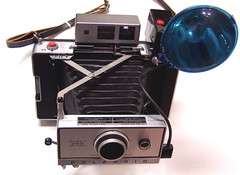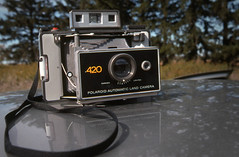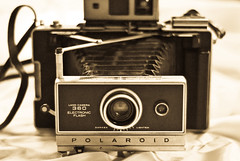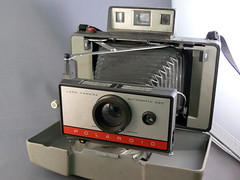Difference between revisions of "Polaroid 100-400 series"
m (→Models) |
m (image attributions/rights into templates) |
||
| Line 1: | Line 1: | ||
{|class=plainlinks | {|class=plainlinks | ||
| + | |colspan=3|'''Models 420, 360 and 220''' | ||
| + | |- | ||
||{{Flickr_image | ||{{Flickr_image | ||
|image_source= http://www.flickr.com/photos/michaelraso/5204323878/in/pool-camerawiki | |image_source= http://www.flickr.com/photos/michaelraso/5204323878/in/pool-camerawiki | ||
| Line 5: | Line 7: | ||
|image_align= | |image_align= | ||
|image_text= | |image_text= | ||
| − | |image_by= | + | |image_by= Michael Raso |
|image_rights= With permission | |image_rights= With permission | ||
}} | }} | ||
| Line 13: | Line 15: | ||
|image_align= | |image_align= | ||
|image_text= | |image_text= | ||
| − | |image_by= | + | |image_by= Douglas Elsberry |
|image_rights= With permission | |image_rights= With permission | ||
}} | }} | ||
| Line 21: | Line 23: | ||
|image_align= | |image_align= | ||
|image_text= | |image_text= | ||
| − | |image_by= | + | |image_by= Marty4650 |
|image_rights= With permission | |image_rights= With permission | ||
}} | }} | ||
| − | |||
| − | |||
|} | |} | ||
| Line 53: | Line 53: | ||
<div class="floatright plainlinks" style="text-align: center;"> | <div class="floatright plainlinks" style="text-align: center;"> | ||
[http://www.flickr.com/photos/timmythesuk/2060880240/ http://farm3.static.flickr.com/2339/2060880240_a85dec57e1_m.jpg] | [http://www.flickr.com/photos/timmythesuk/2060880240/ http://farm3.static.flickr.com/2339/2060880240_a85dec57e1_m.jpg] | ||
| − | + | Model 100 </div> | |
<div class="floatright plainlinks" style="text-align: center;"> | <div class="floatright plainlinks" style="text-align: center;"> | ||
[http://www.flickr.com/photos/timmythesuk/2060880130/ http://farm3.static.flickr.com/2402/2060880130_af399b67a8_o.jpg] | [http://www.flickr.com/photos/timmythesuk/2060880130/ http://farm3.static.flickr.com/2402/2060880130_af399b67a8_o.jpg] | ||
| − | + | Model 104</div> | |
<div class="floatright plainlinks" style="text-align: center;"> | <div class="floatright plainlinks" style="text-align: center;"> | ||
[http://www.flickr.com/photos/timmythesuk/2060098563/ http://farm3.static.flickr.com/2414/2060098563_e8bed5b239_o.jpg] | [http://www.flickr.com/photos/timmythesuk/2060098563/ http://farm3.static.flickr.com/2414/2060098563_e8bed5b239_o.jpg] | ||
| − | + | Model 350<br/><small>viewfinder images by {{image author|Tim Williams}}</small></div> | |
| Line 74: | Line 74: | ||
The third type of viewfinder common in the series is that used on the [[Polaroid_Land_Model_250|250]],[[Polaroid_Land_Model_350|350]] and other 3-element glass lens models: a high quality Zeiss-Ikon designed, single-window, parallax-corrected combination range and viewfinder. | The third type of viewfinder common in the series is that used on the [[Polaroid_Land_Model_250|250]],[[Polaroid_Land_Model_350|350]] and other 3-element glass lens models: a high quality Zeiss-Ikon designed, single-window, parallax-corrected combination range and viewfinder. | ||
==Models== | ==Models== | ||
| − | + | ||
| − | |||
| − | |||
| − | |||
| − | |||
| − | |||
* [[Polaroid Land Model 100|Polaroid Land Camera Automatic 100]] | * [[Polaroid Land Model 100|Polaroid Land Camera Automatic 100]] | ||
* Polaroid Land Camera 101 Automatic | * Polaroid Land Camera 101 Automatic | ||
| Line 95: | Line 90: | ||
* Polaroid Automatic 320 Land Camera | * Polaroid Automatic 320 Land Camera | ||
* Polaroid Automatic 330 Land Camera | * Polaroid Automatic 330 Land Camera | ||
| + | {{Flickr image | ||
| + | | image_source=http://www.flickr.com/photos/inkyfingerz/2220977508/in/pool-camerapedia | ||
| + | | image=http://farm3.static.flickr.com/2413/2220977508_34f89dfb25_m.jpg | ||
| + | | image_align=right | ||
| + | | image_text=Model 350 | ||
| + | |image_by= inkyfingerz | ||
| + | |image_rights=wp | ||
| + | }} | ||
* [[Polaroid Land Model 340|Polaroid Automatic 340 Land Camera]] | * [[Polaroid Land Model 340|Polaroid Automatic 340 Land Camera]] | ||
* [[Polaroid Land Model 350|Polaroid Automatic 350 Land Camera]] | * [[Polaroid Land Model 350|Polaroid Automatic 350 Land Camera]] | ||
Revision as of 05:27, 28 May 2011
| Models 420, 360 and 220 | ||||||||
|
|
| ||||||

|
| Model 350 with external flash #268 image by Erich Z (Image rights) |
This series of Polaroid cameras, starting with the Automatic Land Camera 100 and finishing at the Automatic Land Camera 450, all share a common set of features:
- Folding bellows
- Automatic exposure, with an external 'Electric Eye' lightmeter beside the lens
- Designed for Polaroid 100-series Packfilm
There is a very large variety within this vast range of essentially similar folding Polaroid models. The best 'standard' models are the 100, 250, 350, and 450 variants of the line. These feature a coupled rangefinder designed by the German firm Zeiss Ikon, rigid metal bodies and 3 element glass lenses. Most other models, such as the 103, 220 or 430 have a much cheaper build quality and features including plastic lenses, rigid viewfinders, moulded plastic bodies and many lack a tripod socket.
All these cameras produce 7.2×9.5cm prints on Polaroid 100-series packfilm, and the more expensively produced models can be capable of very good results. Many accessories were made for these cameras including, but not limited to, portrait kits, close-up kits, and electric external flashes.
A few models to be aware of are the 180, 185, 190, and 195 cameras. These professional-model Polaroid Land Cameras are among the best cameras Polaroid has ever produced, and are vastly superior to the rest of the 100-400 line as they include much faster glass lenses, fully mechanical leaf shutters, and manual exposure functionality. These models lack the built-in lightmeter the other models use to calculate exposure, and are capable of excellent results, on par with the best professional Polaroid cameras ever made - like the 600 SE.
Viewfinder & Rangefinder variants
There are several main types of view and range finder used throughout the folding land camera series, the most common being a two-window split system (as featured on the Automatic 100) whereby the user first makes focus using a small window with a circular (or, more commonly, square) shifting ranged image, and then moves the eye to a larger non-parallax corrected viewfinder with marked frame-lines for composing the shot.
This type of viewfinder was on all the very early models in the series, and continued to be used on many of the mid- and low-tier models over the life cycle of the folding packfilm camera series. Both folding and non-folding models of this viewfinder type exist; the folding type is more common on early models with higher quality lenses.
The second, and one of the more uncommon types of viewfinder used was a single window non-rangefinder variant. This type of viewfinder was used on the 104, and used a type of zone-focusing system, with subject distance selectable within the viewfinder, and two vertically travelling lines designed to be used to mark the top of a subject's forehead and their chin, to ensure correct focusing for portraiture.
This zone-focusing viewfinder also features parallax-corrected marks for judging correct subject framing at different focal distances. In the instruction manual for the 104, Polaroid includes several illustrated tips on how to ensure correct use of the focusing system on varied subjects. This viewfinder type is non-folding, and so camera models with this type of viewfinder have a slightly different case design to those with folding optics.
The third type of viewfinder common in the series is that used on the 250,350 and other 3-element glass lens models: a high quality Zeiss-Ikon designed, single-window, parallax-corrected combination range and viewfinder.
Models
- Polaroid Land Camera Automatic 100
- Polaroid Land Camera 101 Automatic
- Polaroid Land Camera 102 Automatic
- Polaroid Land Camera Automatic 103
- Polaroid Land Camera Automatic 104
- Polaroid 195 Land Camera
- Polaroid Land Camera Automatic 210
- Polaroid Land Camera Automatic 220
- Polaroid Land Camera Automatic 225
- Polaroid Land Camera Automatic 230
- Polaroid Automatic 240 Land Camera
- Polaroid Automatic 250 Land Camera
- Polaroid Automatic 315 Land Camera
- Polaroid Automatic 320 Land Camera
- Polaroid Automatic 330 Land Camera

|
| Model 350 image by inkyfingerz (Image rights) |
- Polaroid Automatic 340 Land Camera
- Polaroid Automatic 350 Land Camera
- Polaroid Automatic 355 Land Camera
- Polaroid Land Camera 360 Electronic Flash
- Polaroid Automatic Land Camera 420
- Polaroid Automatic Land Camera 430
- Polaroid Automatic Land Camera 440
- Polaroid Automatic Land Camera 450
Links
- The Land List - An Ongoing Project in Cataloging Polaroid Cameras
- Polaroid.com - Polaroid's User Guide for folding packfilm cameras (.pdf)
- Polaroid cameras and manuals on www.collection-appareils.fr by Sylvain Halgand
- 100, 101, 104, 195, 210, 225, 230, 315, 320, 330, 340, 350, 355, 440 on www.collection-appareils.fr by Sylvain Halgand
- Picture Gallery using Polaroid 100 series www.picturenoise.com





